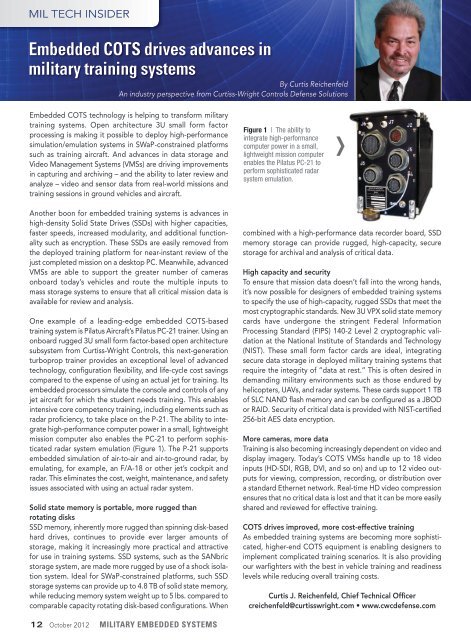Software-Defined Radio technology and market outlook
Software-Defined Radio technology and market outlook
Software-Defined Radio technology and market outlook
You also want an ePaper? Increase the reach of your titles
YUMPU automatically turns print PDFs into web optimized ePapers that Google loves.
MIL TECH INSIDER<br />
Embedded COTS drives advances in<br />
military training systems<br />
By Curtis Reichenfeld<br />
An industry perspective from Curtiss-Wright Controls Defense Solutions<br />
Embedded COTS <strong>technology</strong> is helping to transform military<br />
training systems. Open architecture 3U small form factor<br />
processing is making it possible to deploy high-performance<br />
simulation/emulation systems in SWaP-constrained platforms<br />
such as training aircraft. And advances in data storage <strong>and</strong><br />
Video Management Systems (VMSs) are driving improvements<br />
in capturing <strong>and</strong> archiving – <strong>and</strong> the ability to later review <strong>and</strong><br />
analyze – video <strong>and</strong> sensor data from real-world missions <strong>and</strong><br />
training sessions in ground vehicles <strong>and</strong> aircraft.<br />
Figure 1 | The ability to<br />
integrate high-performance<br />
computer power in a small,<br />
lightweight mission computer<br />
enables the Pilatus PC-21 to<br />
perform sophisticated radar<br />
system emulation.<br />
›<br />
Another boon for embedded training systems is advances in<br />
high-density Solid State Drives (SSDs) with higher capacities,<br />
faster speeds, increased modularity, <strong>and</strong> additional functionality<br />
such as encryption. These SSDs are easily removed from<br />
the deployed training platform for near-instant review of the<br />
just completed mission on a desktop PC. Meanwhile, advanced<br />
VMSs are able to support the greater number of cameras<br />
onboard today’s vehicles <strong>and</strong> route the multiple inputs to<br />
mass storage systems to ensure that all critical mission data is<br />
available for review <strong>and</strong> analysis.<br />
One example of a leading-edge embedded COTS-based<br />
training system is Pilatus Aircraft’s Pilatus PC-21 trainer. Using an<br />
onboard rugged 3U small form factor-based open architecture<br />
subsystem from Curtiss-Wright Controls, this next-generation<br />
turboprop trainer provides an exceptional level of advanced<br />
<strong>technology</strong>, configuration flexibility, <strong>and</strong> life-cycle cost savings<br />
compared to the expense of using an actual jet for training. Its<br />
embedded processors simulate the console <strong>and</strong> controls of any<br />
jet aircraft for which the student needs training. This enables<br />
intensive core competency training, including elements such as<br />
radar proficiency, to take place on the P-21. The ability to integrate<br />
high-performance computer power in a small, lightweight<br />
mission computer also enables the PC-21 to perform sophisticated<br />
radar system emulation (Figure 1). The P-21 supports<br />
embedded simulation of air-to-air <strong>and</strong> air-to-ground radar, by<br />
emulating, for example, an F/A-18 or other jet’s cockpit <strong>and</strong><br />
radar. This eliminates the cost, weight, maintenance, <strong>and</strong> safety<br />
issues associated with using an actual radar system.<br />
Solid state memory is portable, more rugged than<br />
rotating disks<br />
SSD memory, inherently more rugged than spinning disk-based<br />
hard drives, continues to provide ever larger amounts of<br />
storage, making it increasingly more practical <strong>and</strong> attractive<br />
for use in training systems. SSD systems, such as the SANbric<br />
storage system, are made more rugged by use of a shock isolation<br />
system. Ideal for SWaP-constrained platforms, such SSD<br />
storage systems can provide up to 4.8 TB of solid state memory,<br />
while reducing memory system weight up to 5 lbs. compared to<br />
comparable capacity rotating disk-based configurations. When<br />
combined with a high-performance data recorder board, SSD<br />
memory storage can provide rugged, high-capacity, secure<br />
storage for archival <strong>and</strong> analysis of critical data.<br />
High capacity <strong>and</strong> security<br />
To ensure that mission data doesn’t fall into the wrong h<strong>and</strong>s,<br />
it’s now possible for designers of embedded training systems<br />
to specify the use of high-capacity, rugged SSDs that meet the<br />
most cryptographic st<strong>and</strong>ards. New 3U VPX solid state memory<br />
cards have undergone the stringent Federal Information<br />
Processing St<strong>and</strong>ard (FIPS) 140-2 Level 2 cryptographic validation<br />
at the National Institute of St<strong>and</strong>ards <strong>and</strong> Technology<br />
(NIST). These small form factor cards are ideal, integrating<br />
secure data storage in deployed military training systems that<br />
require the integrity of “data at rest.” This is often desired in<br />
dem<strong>and</strong>ing military environments such as those endured by<br />
helicopters, UAVs, <strong>and</strong> radar systems. These cards support 1 TB<br />
of SLC NAND flash memory <strong>and</strong> can be configured as a JBOD<br />
or RAID. Security of critical data is provided with NIST-certified<br />
256-bit AES data encryption.<br />
More cameras, more data<br />
Training is also becoming increasingly dependent on video <strong>and</strong><br />
display imagery. Today’s COTS VMSs h<strong>and</strong>le up to 18 video<br />
inputs (HD-SDI, RGB, DVI, <strong>and</strong> so on) <strong>and</strong> up to 12 video outputs<br />
for viewing, compression, recording, or distribution over<br />
a st<strong>and</strong>ard Ethernet network. Real-time HD video compression<br />
ensures that no critical data is lost <strong>and</strong> that it can be more easily<br />
shared <strong>and</strong> reviewed for effective training.<br />
COTS drives improved, more cost-effective training<br />
As embedded training systems are becoming more sophisticated,<br />
higher-end COTS equipment is enabling designers to<br />
implement complicated training scenarios. It is also providing<br />
our warfighters with the best in vehicle training <strong>and</strong> readiness<br />
levels while reducing overall training costs.<br />
Curtis J. Reichenfeld, Chief Technical Officer<br />
creichenfeld@curtisswright.com • www.cwcdefense.com<br />
12 October 2012 MILITARY EMBEDDED SYSTEMS
















